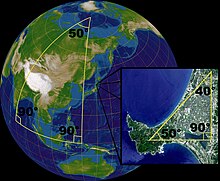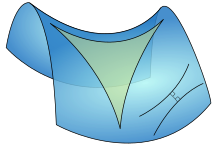Non-Euclidean Geometry
The non-Euclidean geometries are specializations of absolute geometry . They differ from Euclidean geometry , which can also be formulated as a specialization of absolute geometry, in that the axiom of parallels does not apply in them .

history
The non-Euclidean geometries developed from centuries of unsuccessful attempts to prove the parallel axiom of Euclidean geometry. At the beginning of the 19th century, the mathematicians János Bolyai , Nikolai Lobatschewski and Carl Friedrich Gauß determined that there was not necessarily a Euclidean geometry of space, and began to develop a non-Euclidean geometry. Other forerunners were Ferdinand Karl Schweikart , Franz Taurinus , Giovanni Girolamo Saccheri and Johann Heinrich Lambert . Carl Friedrich Gauß did not publish his results at all.
Between 1818 and 1826 Gauß headed the Hanoverian land surveying and developed methods with considerably increased accuracy. In this context, the idea arose that he was looking empirically for a curvature of the room by measuring the sum of the angles in a triangle formed by the Brocken in the Harz Mountains , the Inselsberg in the Thuringian Forest and the Hohen Hagen near Göttingen . Today it is seen by the majority as a legend, even if the possibility that Gauss was looking for deviations from the usual value of the angle sum of 180 ° cannot be ruled out with ultimate consequence. However, the accuracy of his instruments would have been far from sufficient to prove the tiny curvature of space in the earth's gravitational field. It is still not possible today.
It was Gauss' student Bernhard Riemann who developed the differential geometry of curved spaces and presented it in 1854. At the time, nobody expected this topic to be physically relevant. Tullio Levi-Civita , Gregorio Ricci-Curbastro and Elwin Bruno Christoffel further expanded the differential geometry. Einstein found a variety of mathematical tools for his general theory of relativity in their work .
Basics
The non-Euclidean geometries were not developed with the aim of making our spatial experience more precise, but as axiomatic theories in dealing with the problem of parallels . The existence of models for non-Euclidean geometries (e.g. by Felix Klein and Henri Poincaré ) proves that the parallel axiom of Euclid cannot be deduced from the other axioms and is independent of them.
One obtains non-Euclidean geometries by removing the axiom of parallels from the system of axioms or by changing it. The basic change options are:
- There is no parallel to a straight line and a point outside the straight line. So two different straight lines in one plane always intersect. This leads to an elliptical geometry . A clear model of a two-dimensional elliptical geometry is the geometry on a spherical surface . Here the sum of the angles of a triangle is greater than 180 °, the circumference of a circle is less than and the area is less than . In elliptical geometry, however, the axioms of arrangement no longer apply unchanged.
- There are at least two parallels to a straight line and a point outside the straight line. Here all other axioms can be preserved. A hyperbolic geometry is obtained . It can be described in two ways by the models of Klein and Poincaré. In miniature (or locally) it can be visualized on a saddle surface of constant Gaussian curvature (the so-called pseudosphere ). The sum of the angles of a triangle is now less than 180 °, the circumference of a circle is more than and its area is more than .
Meanwhile, non-Euclidean geometry plays an important role in theoretical physics and cosmology . According to the general theory of relativity , the geometry of the universe differs from the Euclidean one because gravity fields "bend" space. Whether the geometry of the universe “on a large scale” is spherical (elliptical), even (Euclidean) or hyperbolic is one of the major current questions in physics.
literature
- Felix Klein : Lectures on non-Euclidean geometry . Julius Springer, Berlin 1928 (XII, 326, online ). Reprint Felix Klein: like VDM, Müller, Saarbrücken 2006, ISBN 3-8364-0097-9 (XII, 326).
- Julian L. Coolidge : The elements of non-Euclidean geometry. Cornell Univ. Library, Cornell 2008, ISBN 978-1-4297-0446-5
- Nikolai I. Lobachevsky, Pangeometry, Translator and Editor: A. Papadopoulos, Heritage of European Mathematics Series, Vol. 4, European Mathematical Society, 2010.
- Norbert A'Campo , Athanase Papadopoulos, Notes on hyperbolic geometry . In: Strasbourg Master class on Geometry, pp. 1--182, IRMA Lectures in Mathematics and Theoretical Physics, Vol. 18, Zurich: European Mathematical Society (EMS), 461 pages, 2012, ISBN 978-3-03719-105-7 , doi: 10.4171 / 105 .
- Marvin J. Greenberg : Euclidean and non-Euclidean geometries - development and history. Freeman, New York 2008, ISBN 978-0-7167-9948-1
- Boris A. Rozenfel'd : A history of non-Euclidean geometry - evolution of the concept of a geometric space. Springer, New York 1988, ISBN 3-540-96458-4
- János Bolyai, (et al.): Non-euclidean geometries. Springer, New York 2006, ISBN 978-0-387-29554-1
- Benno Klotzek: Euclidean and non-Euclidean elementary geometries . 1st edition. Harri Deutsch, Frankfurt am Main 2001, ISBN 3-8171-1583-0 .
Notes and individual references
- ↑ For more information on the history of non-Euclidean geometry, see the article Parallels axiom



